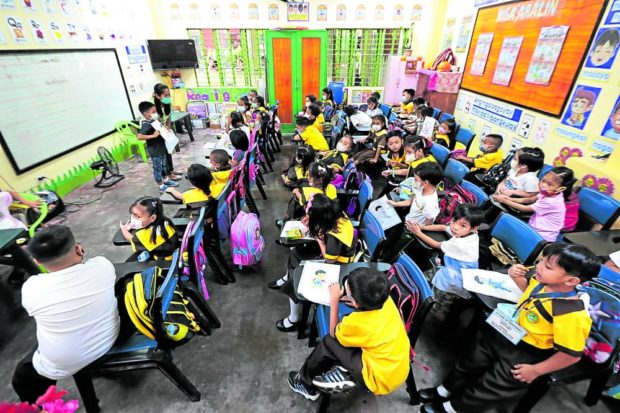‘Calculator’ developed to make schools safer

FULL CLASS | In this photo taken on Aug. 22, 2022, Grade 1 pupils at San Diego Elementary School in Quezon City are each called in front of their class to recite their lessons. (File photo by GRIG C. MONTEGRANDE / Philippine Daily Inquirer0
MANILA, Philippines — To help teachers ensure proper ventilation during face-to-face classes, a wind engineer from the University of the Philippines (UP) has developed a “calculator” that can measure the risk level for COVID-19 transmission inside classrooms.
Seeing that the Department of Education (DepEd) did not list specific measures for ensuring “adequate ventilation” in classrooms aside from opening windows and doors, UP engineering professor Joshua Agar collaborated with Aral Pilipinas Coalition, a multisectoral network advocating safe school reopening, on the “Safe Schools Calculator.”
Downloadable via this link — Safe Schools Calculator — the tool provides data on the carbon dioxide (CO2) level inside a classroom to help determine whether it is poorly or well-ventilated, the probability of infection, and the reproduction number — or how many people can get infected if one of those inside is COVID-positive.
To get the information, teachers must input data such as the dimension of the classroom, number of students, type of face mask being used, number of fans and/or air purifiers, and duration of stay or classes.
According to Department of Health protocols, CO2 concentration in schools should be at or below 1,000 parts per million, which can be calculated using the Safe Schools Calculator.
Article continues after this advertisement“You are free to adjust the measurements because the reality is that classrooms have different scenarios. This tool will help you determine the degree of risk to formulate certain parameters so that you can ensure that your classroom is safe given the situation that you have,” Agar said in an interview.
Article continues after this advertisementHe cited as an example the following: If a teacher and students stay for four hours in a poorly ventilated classroom with all windows closed, the calculator will show the reproduction number at 29, meaning 29 others can be infected by a lone symptomatic person.
Engineering controls
The teacher, Agar said, could address the situation by using “engineering controls” such as opening windows or adding more electric fans to minimize the CO2 level inside the classroom.
Another solution would be to consider “administrative controls” like reducing the number of occupants or students to cut the CO2 level, although the UP professor noted this would not be possible in schools with a classroom shortage.
“So you need to balance the shortcomings [based on] the hierarchy of interventions,” Agar said.
Abbey Pangilinan, Aral Pilipinas Coalition co-convener, said they received positive feedback from a school in San Juan City which conducted a pilot test of the calculator.
“My recollection when I presented the calculator is always the excitement [because teachers] finally know how to quantify the risk and they also know how to address it,” Agar added.
In a Viber message to the Inquirer, DepEd spokesperson Michael Poa said they were “still studying” the tool.
Optional masking ‘dangerous’
Regina Sibal, a teacher and the coalition’s lead convener, said the Safe Schools Calculator was their “call to action” for stakeholders not to compromise specific measures in the resumption of in-person classes.
“This is not a one-size-fits-all solution but this is more on prevention,” she said.
On DepEd’s announcement last week that face masks may be optional for students in open/noncrowded areas in schools in line with the President’s Executive Order No. 3, a health reform advocate on Sunday cautioned the agency to “play it cool” because children were “not completely protected” yet.
Tony Leachon, former adviser of the National Task Force Against COVID-19, said the move was “dangerous” considering the high positivity rate at the moment.
“The kids were the last to be vaccinated and some are without boosters so if you open up, they would get sick,” he told the Inquirer in a phone interview.
“We cannot just decide this on hindsight only. Our interest should not be a knee-jerk reaction but based on data and based on good policy in the interest of public safety, particularly [children] who are the most vulnerable,” Leachon said.
He added that to improve health measures in schools, Vice President and Education Secretary Sara Duterte should prioritize ventilation in classrooms and ask school doctors to encourage students to get vaccinated.
Asked for comment, Poa reiterated that masks remain mandatory for school personnel, students, and visitors inside classrooms, laboratories, or other school facilities, as provided by DepEd guidelines.
RELATED STORIES
DepEd asked to issue air ventilation guidelines
DOST backs cheap school ventilation system
DOH: Use open-air spaces in activities, ensure proper ventilation to reduce COVID-19 risk